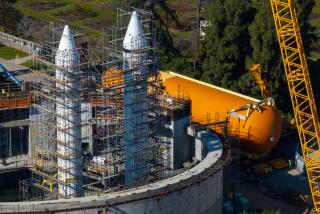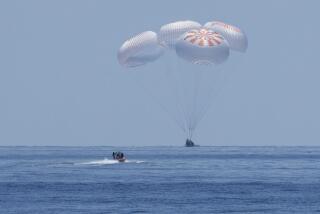Shuttle Passes Test With Flying Colors
- Share via
CAPE CANAVERAL, Fla. — Space shuttle Discovery sailed through a second test of its redesigned fuel tank Friday, clearing the path for final equipment upgrades before NASA can return the shuttle fleet to flight.
“We had just a perfect test as far as I’m concerned,” shuttle program manager Bill Parsons said during a teleconference with reporters after the test.
Managers ordered the fuel tank retested after problems surfaced during a test last month. The U.S. space agency hopes to fly the shuttle in July, more than two years after the fleet was grounded after the shuttle Columbia disintegrated over Texas in February 2003.
One of the key issues in the initial test, which would have stopped the launch if the shuttle were being fueled for flight, involved two of the four sensors that detect whether the tank has the proper level of hydrogen.
Preliminary evaluation of the test data showed the sensors worked perfectly during the second test, said Sandy Coleman, external-tank project manager with NASA’s Marshall Space Flight Center in Huntsville, Ala.
Despite the apparently successful test, Discovery will be swapping its tank and twin boosters with gear that had been earmarked for the next shuttle on the calendar, Atlantis.
Each tank will be outfitted with an additional heater to help ward off ice formation near the top of the tank, which could pose a threat during launch.
Preventing debris from striking the orbiters has been the primary focus of NASA’s efforts to return the fleet to space after the Columbia accident.
Investigators determined the shuttle was destroyed and its seven crew members killed because a piece of foam insulation fell off the fuel tank during launch and slammed into the orbiter’s wing, breaching its protective heat shield. The shuttle was torn apart as it reentered Earth’s atmosphere 16 days later in preparation for landing.
The decision to use Atlantis’ tank, which already is in the assembly building, was made to save time, NASA managers said.
More to Read
Sign up for Essential California
The most important California stories and recommendations in your inbox every morning.
You may occasionally receive promotional content from the Los Angeles Times.













